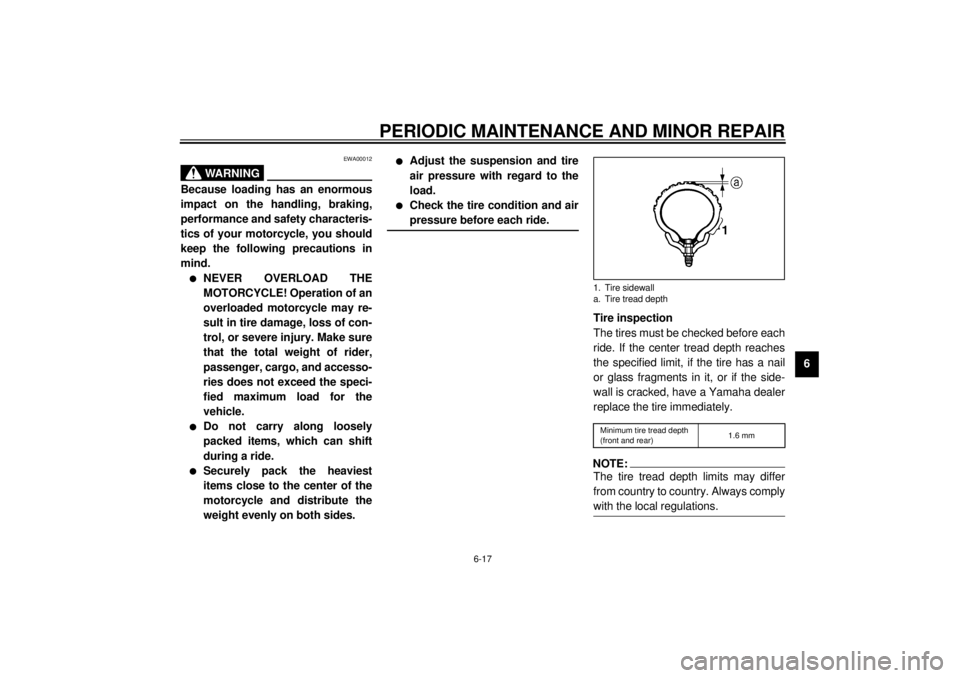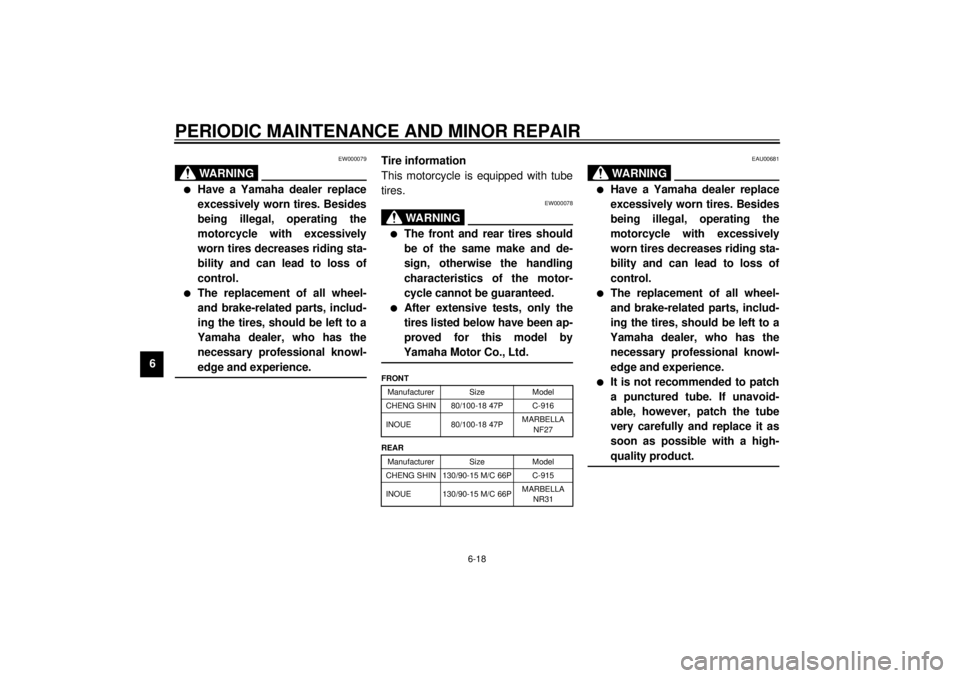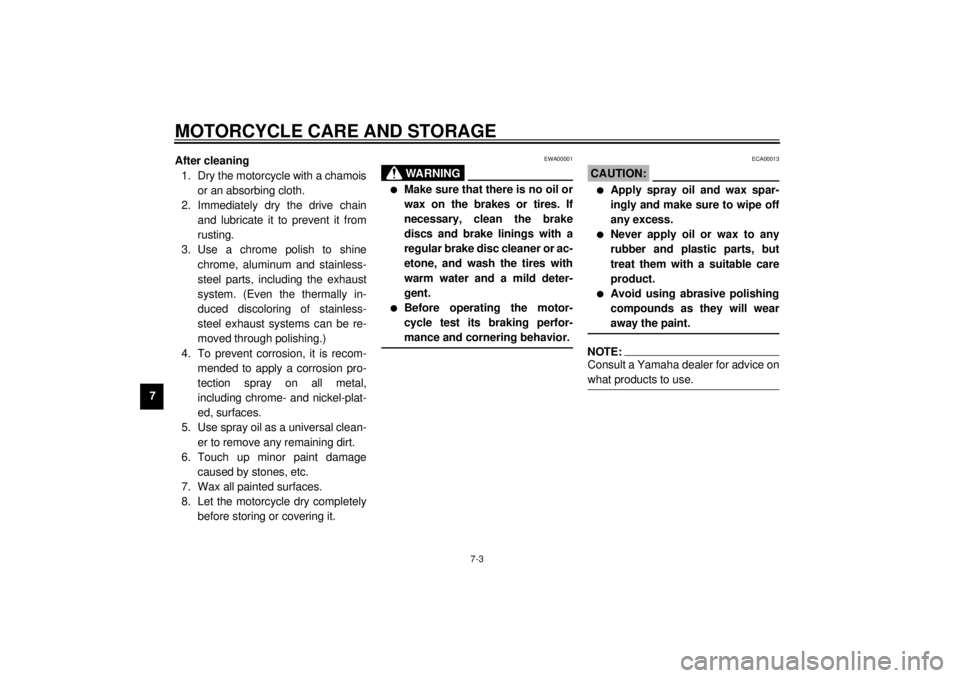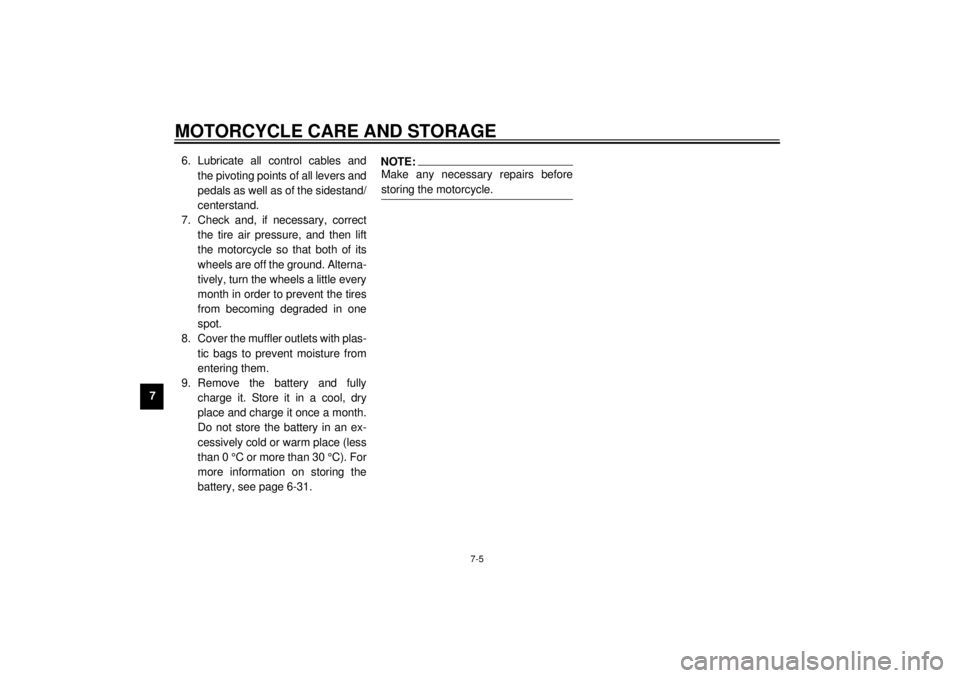2001 YAMAHA XVS250 tires
[x] Cancel search: tiresPage 7 of 88

EAU00009
TABLE OF CONTENTS
GIVE SAFETY THE RIGHT OF WAY .................1-1
DESCRIPTION ...................................................2-1
Left view ............................................................. 2-1
Right view...........................................................2-2
Controls and instruments ................................... 2-3
INSTRUMENT AND CONTROL FUNCTIONS ....3-1
Main switch/steering lock ..................................3-1
Indicator and warning lights ..............................3-2
Speedometer unit ..............................................3-3
Self-diagnosis device ........................................3-3
Anti-theft alarm (optional) ..................................3-3
Handlebar switches ...........................................3-4
Clutch lever .......................................................3-5
Shift pedal .........................................................3-5
Brake lever ........................................................3-6
Brake pedal .......................................................3-6
Fuel tank cap .....................................................3-6
Fuel ...................................................................3-7
Fuel cock ...........................................................3-8
Starter (choke) lever ..........................................3-9
Helmet holder ....................................................3-9
Adjusting the shock absorber assemblies ....... 3-10
Sidestand ........................................................ 3-11
Ignition circuit cut-off system ........................... 3-11PRE-OPERATION CHECKS ...............................4-1
Pre-operation check list .....................................4-1
OPERATION AND IMPORTANT RIDING
POINTS................................................................5-1
Starting the engine ............................................5-1
Starting a warm engine .....................................5-2
Shifting ..............................................................5-3
Recommended shift points
(for Switzerland only) .....................................5-3
Tips for reducing fuel consumption ...................5-4
Engine break-in .................................................5-4
Parking ..............................................................5-5
PERIODIC MAINTENANCE AND MINOR
REPAIR................................................................6-1
Owner’s tool kit ..................................................6-1
Periodic maintenance and lubrication chart ......6-2
Removing and installing panels ........................6-5
Checking the spark plugs ..................................6-8
Engine oil and oil filter element .......................6-10
Cleaning the air filter element .........................6-12
Adjusting the carburetor ..................................6-14
Adjusting the engine idling speed ...................6-15
Adjusting the throttle cable free play ...............6-15
Adjusting the valve clearance .........................6-16
Tires ................................................................6-16
Spoke wheels ..................................................6-19
123
456
E_5kr.book Page 1 Tuesday, September 12, 2000 4:46 PM
Page 26 of 88

PRE-OPERATION CHECKS
4-2
4
Control cables• Make sure that operation is smooth.
• Lubricate if necessary.6-27
Drive chain• Check chain slack.
• Adjust if necessary.
• Check chain condition.
• Lubricate if necessary.6-24–6-25
Wheels and tires• Check for damage.
• Check tire condition and tread depth.
• Check air pressure.
• Correct if necessary.6-16–6-19
Brake and shift pedals• Make sure that operation is smooth.
• Lubricate pedal pivoting points if necessary.6-27
Brake and clutch levers• Make sure that operation is smooth.
• Lubricate lever pivoting points if necessary.6-28
Sidestand• Make sure that operation is smooth.
• Lubricate pivot if necessary.6-28
Chassis fasteners• Make sure that all nuts, bolts and screws are properly tightened.
• Tighten if necessary.—
Instruments, lights, signals
and switches• Check operation.
• Correct if necessary.—
Sidestand switch• Check operation of ignition circuit cut-off system.
• If system is defective, have Yamaha dealer check vehicle.3-11 ITEM CHECKS PAGE
E_5kr.book Page 2 Tuesday, September 12, 2000 4:46 PM
Page 35 of 88

PERIODIC MAINTENANCE AND MINOR REPAIR
6-3
6
10
*Wheels• Check runout, spoke tightness and for damage.
• Tighten spokes if necessary.ÖÖÖÖ
11*Tires• Check tread depth and for damage.
• Replace if necessary.
• Check air pressure.
• Correct if necessary.ÖÖÖÖ
12*Wheel bearings• Check bearing for looseness or damage.ÖÖÖÖ
13*Swingarm• Check operation and for excessive play.ÖÖÖÖ
• Lubricate with molybdenum disulfide grease. Every 50,000 km
14 Drive chain• Check chain slack.
• Make sure that the rear wheel is properly aligned.
• Clean and lubricate.Every 1,000 km and after washing
the motorcycle or riding in the rain.
15*Steering bearings• Check bearing play and steering for roughness.ÖÖÖÖÖ
• Lubricate with lithium-soap-based grease. Every 20,000 km
16*Chassis fasteners• Make sure that all nuts, bolts and screws are properly tightened.ÖÖÖÖ Ö
17 Sidestand• Check operation.
• Lubricate.ÖÖÖÖ Ö
18*Sidestand switch• Check operation.ÖÖÖÖÖ Ö
19*Front fork• Check operation and for oil leakage.ÖÖÖÖ
20*Rear shock absorber
assemblies• Check operation and shock absorbers for oil leakage.ÖÖÖÖ
21*Carburetor• Check starter (choke) operation.
• Adjust engine idling speed.ÖÖÖÖÖ Ö
22 Engine oil• Change.ÖÖÖÖÖ Ö
23 Engine oil filter element• Replace.ÖÖÖ
24*Front and rear brake
switches• Check operation.ÖÖÖÖÖ Ö
25 Moving parts and cables• Lubricate.ÖÖÖÖ Ö NO. ITEM CHECK OR MAINTENANCE JOBODOMETER READING (´1,000 km)
ANNUAL
CHECK
1 10203040
E_5kr.book Page 3 Tuesday, September 12, 2000 4:46 PM
Page 48 of 88

PERIODIC MAINTENANCE AND MINOR REPAIR
6-16
6
EAU00637
Adjusting the valve clearance The valve clearance changes with use,
resulting in improper air-fuel mixture
and/or engine noise. To prevent this
from occurring, the valve clearance
must be adjusted by a Yamaha dealer
at the intervals specified in the periodic
maintenance and lubrication chart.
EAU03362
Tires To maximize the performance, durabil-
ity, and safe operation of your motor-
cycle, note the following points
regarding the specified tires.
Tire air pressure
The tire air pressure should be
checked and, if necessary, adjusted
before each ride.
EW000082
WARNING
_ l
The tire air pressure must be
checked and adjusted on cold
tires (i.e., when the temperature
of the tires equals the ambient
temperature).
l
The tire air pressure must be
adjusted in accordance with the
riding speed and with the total
weight of rider, passenger, car-
go, and accessories approved
for this model.
_
CE-01E
CE-07E
Tire air pressure
(measured on cold tires)
Load* Front Rear
Up to 90 kg175 kPa
(1.75 kg/cm
2,
1.75 bar)200 kPa
(2.00 kg/cm
2,
2.00 bar)
90 kg–maximum225 kPa
(2.25 kg/cm
2,
2.25 bar)225 kPa
(2.25 kg/cm
2,
2.25 bar)
Maximum load* 180 kg
* Total weight of rider, passenger, cargo and
accessories
E_5kr.book Page 16 Tuesday, September 12, 2000 4:46 PM
Page 49 of 88

PERIODIC MAINTENANCE AND MINOR REPAIR
6-17
6
EWA00012
WARNING
_ Because loading has an enormous
impact on the handling, braking,
performance and safety characteris-
tics of your motorcycle, you should
keep the following precautions in
mind. l
NEVER OVERLOAD THE
MOTORCYCLE! Operation of an
overloaded motorcycle may re-
sult in tire damage, loss of con-
trol, or severe injury. Make sure
that the total weight of rider,
passenger, cargo, and accesso-
ries does not exceed the speci-
fied maximum load for the
vehicle.
l
Do not carry along loosely
packed items, which can shift
during a ride.
l
Securely pack the heaviest
items close to the center of the
motorcycle and distribute the
weight evenly on both sides.
l
Adjust the suspension and tire
air pressure with regard to the
load.
l
Check the tire condition and air
pressure before each ride.
_
Tire inspection
The tires must be checked before each
ride. If the center tread depth reaches
the specified limit, if the tire has a nail
or glass fragments in it, or if the side-
wall is cracked, have a Yamaha dealer
replace the tire immediately.CE-08ENOTE:_ The tire tread depth limits may differ
from country to country. Always comply
with the local regulations. _1. Tire sidewall
a. Tire tread depthMinimum tire tread depth
(front and rear)1.6 mm
E_5kr.book Page 17 Tuesday, September 12, 2000 4:46 PM
Page 50 of 88

PERIODIC MAINTENANCE AND MINOR REPAIR
6-18
6
EW000079
WARNING
_ l
Have a Yamaha dealer replace
excessively worn tires. Besides
being illegal, operating the
motorcycle with excessively
worn tires decreases riding sta-
bility and can lead to loss of
control.
l
The replacement of all wheel-
and brake-related parts, includ-
ing the tires, should be left to a
Yamaha dealer, who has the
necessary professional knowl-
edge and experience.
_
Tire information
This motorcycle is equipped with tube
tires.
EW000078
WARNING
_ l
The front and rear tires should
be of the same make and de-
sign, otherwise the handling
characteristics of the motor-
cycle cannot be guaranteed.
l
After extensive tests, only the
tires listed below have been ap-
proved for this model by
Yamaha Motor Co., Ltd.
_CE-10EEAU00681
WARNING
_ l
Have a Yamaha dealer replace
excessively worn tires. Besides
being illegal, operating the
motorcycle with excessively
worn tires decreases riding sta-
bility and can lead to loss of
control.
l
The replacement of all wheel-
and brake-related parts, includ-
ing the tires, should be left to a
Yamaha dealer, who has the
necessary professional knowl-
edge and experience.
l
It is not recommended to patch
a punctured tube. If unavoid-
able, however, patch the tube
very carefully and replace it as
soon as possible with a high-
quality product.
_
FRONT
Manufacturer Size Model
CHENG SHIN 80/100-18 47P C-916
INOUE 80/100-18 47PMARBELLA
NF27
REAR
Manufacturer Size Model
CHENG SHIN 130/90-15 M/C 66P C-915
INOUE 130/90-15 M/C 66PMARBELLA
NR31
E_5kr.book Page 18 Tuesday, September 12, 2000 4:46 PM
Page 76 of 88

MOTORCYCLE CARE AND STORAGE
7-3
7After cleaning
1. Dry the motorcycle with a chamois
or an absorbing cloth.
2. Immediately dry the drive chain
and lubricate it to prevent it from
rusting.
3. Use a chrome polish to shine
chrome, aluminum and stainless-
steel parts, including the exhaust
system. (Even the thermally in-
duced discoloring of stainless-
steel exhaust systems can be re-
moved through polishing.)
4. To prevent corrosion, it is recom-
mended to apply a corrosion pro-
tection spray on all metal,
including chrome- and nickel-plat-
ed, surfaces.
5. Use spray oil as a universal clean-
er to remove any remaining dirt.
6. Touch up minor paint damage
caused by stones, etc.
7. Wax all painted surfaces.
8. Let the motorcycle dry completely
before storing or covering it.
EWA00001
WARNING
_ l
Make sure that there is no oil or
wax on the brakes or tires. If
necessary, clean the brake
discs and brake linings with a
regular brake disc cleaner or ac-
etone, and wash the tires with
warm water and a mild deter-
gent.
l
Before operating the motor-
cycle test its braking perfor-
mance and cornering behavior.
_
ECA00013
CAUTION:_ l
Apply spray oil and wax spar-
ingly and make sure to wipe off
any excess.
l
Never apply oil or wax to any
rubber and plastic parts, but
treat them with a suitable care
product.
l
Avoid using abrasive polishing
compounds as they will wear
away the paint.
_NOTE:_ Consult a Yamaha dealer for advice on
what products to use. _
E_5kr.book Page 3 Tuesday, September 12, 2000 4:46 PM
Page 78 of 88

MOTORCYCLE CARE AND STORAGE
7-5
76. Lubricate all control cables and
the pivoting points of all levers and
pedals as well as of the sidestand/
centerstand.
7. Check and, if necessary, correct
the tire air pressure, and then lift
the motorcycle so that both of its
wheels are off the ground. Alterna-
tively, turn the wheels a little every
month in order to prevent the tires
from becoming degraded in one
spot.
8. Cover the muffler outlets with plas-
tic bags to prevent moisture from
entering them.
9. Remove the battery and fully
charge it. Store it in a cool, dry
place and charge it once a month.
Do not store the battery in an ex-
cessively cold or warm place (less
than 0 °C or more than 30 °C). For
more information on storing the
battery, see page 6-31.
NOTE:_ Make any necessary repairs before
storing the motorcycle. _
E_5kr.book Page 5 Tuesday, September 12, 2000 4:46 PM